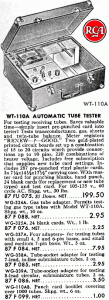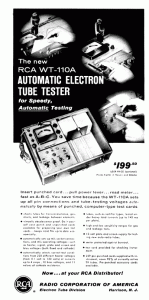RCA Tube Testers
The RCA WT110-A
Here are the only advertisements I could find for the RCA WT110A Automatic Tube Tester. The ads do not have a lot of technical information explaining how it works, but then do we really need to know? It does say enough to lure the prospective buyer over.
What I like about this tester is:
- The set up is ‘automatic’, including socket connections and all appropriate voltages.
- And, speaking of voltages, a 12VDC Plate supply is possible to check the ‘new’ Automobile-Radio tubes.
- Rectifier tubes are tested at 140mA per plate.
- Leakage tests are done using either a high-sensitivity range or a low-sensitivity range. Typical leakage tests, including those seen on B&K tube testers, are limited to spotting about 1Meg leakage resistance.
- It tests ‘twin tube balance’, which is a fancy way of saying you can test both halves of a 6SN7 or a 12AX7 without changing switches or punch cards.
- The ad does mention that the pins are ‘gold plated’, and this came in handy. When I bought my WT110A, it absolutely needed a lot of TLC. The pins were still in great shape, and no excessive cleaning under the panel was required. Bonus!
- Also mentioned in the ad is the thorough testing done; gas, shorts, and the transconductance. This is all done with the simple movement of the Telecaster-style selector switch. Very easy to use.
However, this tester isn’t the perfect ‘be-all-end-all’ tube tester. Remember; no tester is that good. What do I not like about the RCA WT110A? A few things.
- The readings are not on a micromho scale, but an arbitrary ‘Replace – ? – Good’ usually seen on emission testers. This does not inspire confidence, despite the fact that this is a very good tester. I suppose having micromho readings would necessitate reading scales, and that would take away from the simplicity of just inserting a card. It is still disheartening not to be able to ‘see’ how matched the two sections of a 12AX7 are (or are not), and with a little more accuracy than squinting over a ‘Replace-?-Good’ scale.
- Rather than having an AC fuse, RCA uses a 56-ohm resistor. It is difficult to locate, and is not mentioned in the owner’s manual (you need to be able to interpret the schematic)! Not as user-friendly as having a panel-mounted bulb (like Hickok), or even a ‘regular’ fuse.
- The switching is very strange. The switch used is a three-position ‘center-off’ switch. That’s only half of the story; the center position is the ‘Test’ position! It is always good practice to do ‘Shorts’ tests before testing any tube; if the tube fails the ‘Shorts’ test, no further testing is advised. However, it is possible to have the ‘SELECTOR’ control to ‘QUALITY’ by an oversight, and have a shorted tube ‘pin’ the meter movement. You are supposed to hold the ‘CALIBRATE/TEST’ switch in the ‘calibrate’ mode (which is just a ‘Line Adjust’ setting) and set the meter movement to show ‘center-scale’ while the tube is warming up. I damn near wrecked the meter movement once, and I believe this is how that almost happened. While the tube was warming up (it was not shorted at all), the meter was measuring full B+ until the tube ‘settled down’, and a voltage drop was developed across a plate load. As I watched the needle try to jump right out of the meter housing, I cursed RCA, and all of their heirs.
I still really like the RCA WT110A; it is a very good tester. If you buy one, please make sure you have the owner’s manual. The calibration is very difficult at the best of times, and without the manual it is useless to even try and ‘wing it’. And an ‘un-calibrated’ tube tester is just as useless.




